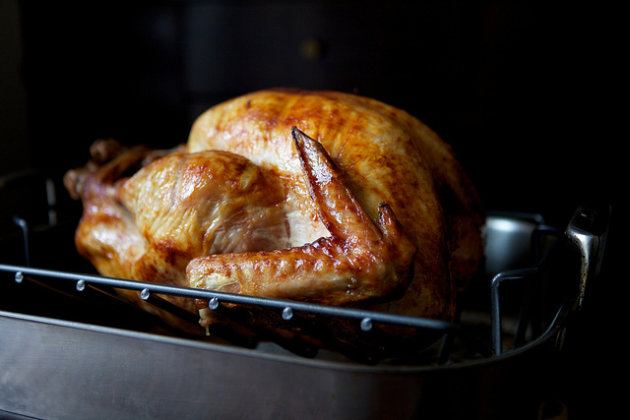
Six years ago, the L.A. Times Food Section held a turkey taste test that changed the way they (a lot of others) talk about Thanksgiving.
Under the vigilant eye of Russ Parsons -- longtime Food Editor at the paper and author of How to Read a French Fry -- four birds came to the table, and a simple new technique had the panel smitten.
The bird had been dry-brined (though the term "dry-brining" wasn't being tossed around much yet). In less-fancy words, a few tablespoons of salt had been sprinkled on it a few days ahead.
Because of this, the turkey was well-seasoned through and through, and had all the juiciness of your average wet-brined turkey, without its sometimes off-putting texture (we'll come back to that later). It tasted like turkey, but turkey having a very good day.
Parsons has written about the salting technique every Thanksgiving since, testing new variations each year and slashing steps he decides aren't important. The response has been glowing. By his count, he's received over 1,000 emails from happy cooks, and some of the most genius hacks have come from their suggestions.
So where had this turkey been all our lives? To find out, I had to get the story from the two clever cooks we have to thank for the recipe: one an editor, the other a chef. Without both parties, the world might never have known the wonder that is the Judy Bird.
Here's how it all went down:
Since the late 1980s, Judy Rodgers has dry-brined the famous roast chicken -- and just about everything else -- at Zuni Café in San Francisco. She learned the technique while cooking in Southwestern France and perfected it back in the States, meticulously trying it on everything from fish fillets to hamburgers to roasts, even some vegetables -- but never a turkey.
Salting early doesn't dry these things out -- if timed and measured right, moisture is pulled out and back in again, and the process magically realigns the proteins so that they'll hold on tighter next time. I can tell you what this means to your mouth: juicy, tender food. As a bonus, it's salted all the way to its middle, not just on the surface.
This juice-retaining action is the same as with a wet brine, with one big difference: the wet version also draws in some of the surrounding water and makes everything vaguely ham-like. Juicy yes, and flavorful, but springy and tight in a way that doesn't smack of fresh meat. Not to mention the space concerns: wet brines are greedy things. Not only are you storing something in your fridge for several days, you're storing it in a vat of liquid.
Enter Parsons, circa 2006, who had quizzed Rodgers on her relationship with salt for various stories over the years. "I was casting about for Thanksgiving ideas and I wondered if something that worked for chicken might work for turkey." Parsons wrote to me in an email, "I called her and asked if she's ever tried it and she said no."
In fact, Rodgers had recommended a wet brine for turkey in the Zuni Café Cookbook in 2002, a recipe she's been using on pork chops since her days at Chez Panisse in the 1980s and had scaled up successfully for the big unwieldy bird. Though she has dry-brined plenty of geese and ducks (and more chickens than probably anyone on earth), the reason she never pursued turkey is simple.
"I'm just not a big turkey, Thanksgiving girl," Rodgers says. "A lot of chefs feel this way. At Zuni we still change the menu every day, and sometimes I taste 75 things in the course of a day, from oysters to desserts. So for me, Thanksgiving is a holiday from cooking and eating. If I don't have to plan a menu, I think, 'It would be really nice to just scramble some eggs'."
So Rodgers consulted and Parsons got testing. "I tried it first with a 12-pounder and it worked great. Then I worked my way up," Parsons wrote. "When I talked to Judy, I think she was a little surprised … and maybe a little amused that I was so excited about it. I can get a little geeky."
Geeky like a fox. Since then, he's figured out, among other things, that you can brine a frozen bird as it defrosts in your refrigerator. And why wouldn't you?
Once you taste your very own Judy Bird, you can thank them both: the chef who'd rather not think about Thanksgiving at all, and the food editor whose job depends on it.














No comments